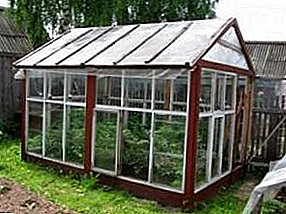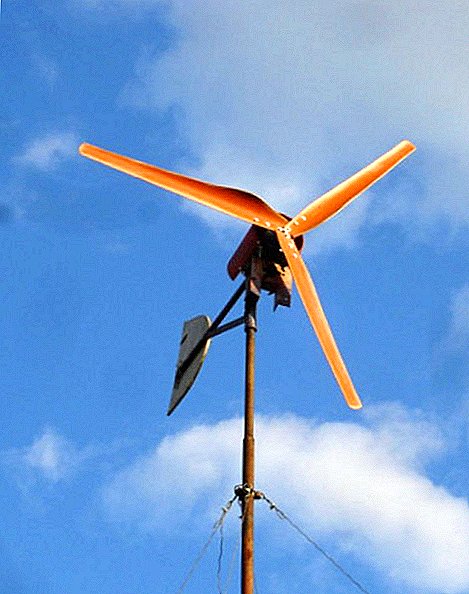 In recent years, the topic of green energy has become extremely popular. Some even predict that such energy in the near future will completely replace coal, gas, nuclear power plants. One of the areas of green energy is wind power. Generators that convert wind energy into electricity, are not only industrial, as part of wind farms, but also small, serving a private farm.
In recent years, the topic of green energy has become extremely popular. Some even predict that such energy in the near future will completely replace coal, gas, nuclear power plants. One of the areas of green energy is wind power. Generators that convert wind energy into electricity, are not only industrial, as part of wind farms, but also small, serving a private farm.
You can even make a wind generator with your own hands - this material is dedicated to it.
What is a generator
In a broad sense, a generator is a device that produces some kind of product or converts one kind of energy into another. This could be, for example, a steam generator (produces steam), an oxygen generator, a quantum generator (a source of electromagnetic radiation).  But within the framework of this topic we are interested in electric generators. This name refers to devices that convert various types of non-electric energy into electricity.
But within the framework of this topic we are interested in electric generators. This name refers to devices that convert various types of non-electric energy into electricity.
Types of generators
Electricity generators are classified as:
- electromechanical - they convert mechanical work into electricity;
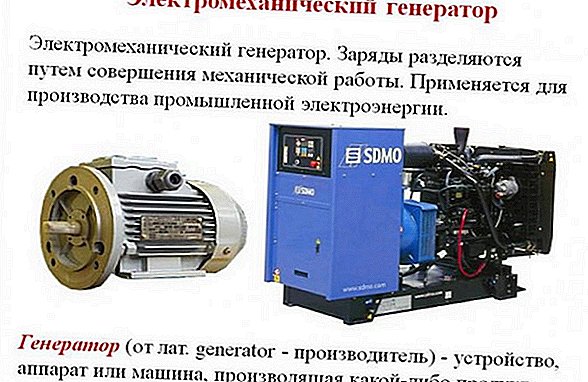
- thermoelectric - convert thermal energy into electricity;
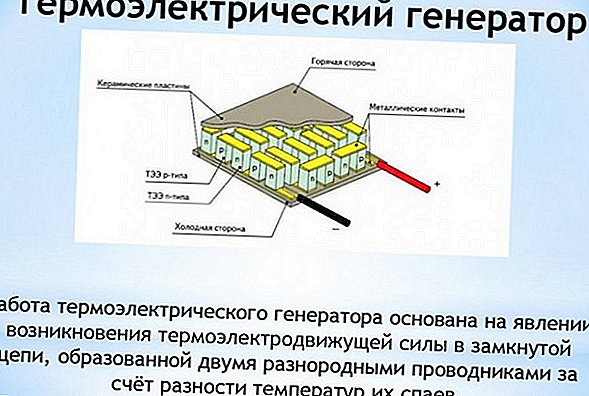
- photoelectric (photovoltaic cells, solar panels) - convert light into electricity;
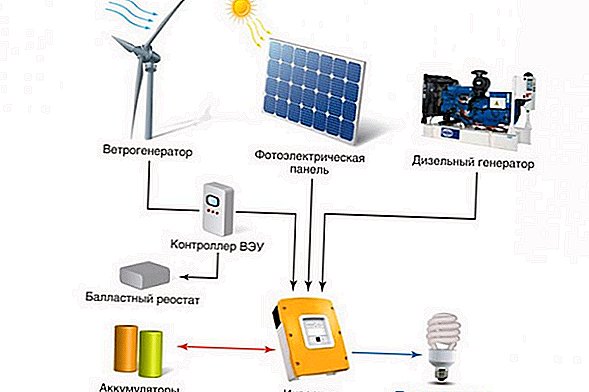
- magnetohydrodynamic (MHD-generators) - electricity is generated from plasma energy moving through a magnetic field;

- chemical - convert the energy of chemical reactions into electricity.
In addition, electromechanical generators are classified by type of engine. There are the following types of them:
- turbine generators are driven by a steam turbine;
- hydrogenerators use a hydraulic turbine as an engine;
- diesel generators or gasoline generators are made on the basis of diesel or gasoline engines;
- wind generators convert the energy of air masses into electricity using a wind turbine.
Wind turbines
More details on the wind turbines (they are also called wind turbines). The simplest low-power wind turbine usually consists of a mast, as a rule, strengthened by stretch marks, on which the wind turbine is installed.
This wind turbine is unwound with a screw driving the rotor of the electric generator. The device, in addition to the electric generator, also includes a battery with a charge controller and an inverter connected to the mains.
Did you know? By 2016, the total capacity of all wind generating plants in the world was 432 GW. Thus, wind power has surpassed nuclear power in power.
The scheme of operation of this device is quite simple: under the action of the wind, the screw rotates, unwinding the rotor, the electric generator produces an alternating electric current, which is converted by the charge controller to direct current.  This current is charging the battery. The direct current coming from the battery is converted by the inverter into alternating current, the parameters of which correspond to the parameters of the power grid.
This current is charging the battery. The direct current coming from the battery is converted by the inverter into alternating current, the parameters of which correspond to the parameters of the power grid.
Industrial devices are mounted on towers. They are additionally equipped with a rotating mechanism, an anemometer (a device for measuring wind speed and direction), a device for changing the angle of rotation of the blades, a braking system, a power cabinet with control circuits, fire extinguishing systems and lightning protection, a system for transmitting data on the installation operation, etc.
Types of wind turbines
The location of the axis of rotation relative to the earth's surface wind turbines are divided into vertical and horizontal. The simplest vertical model is a Savonius rotor mount..
It has two or more blades, which are hollow semi-cylinders (cylinders cut in half vertically).  Savonius rotor There are various options for the layout and design of these blades: symmetrically fixed, setting the edges of each other, with an aerodynamic profile.
Savonius rotor There are various options for the layout and design of these blades: symmetrically fixed, setting the edges of each other, with an aerodynamic profile.
The advantage of the Savonius rotor is the simplicity and reliability of the design, moreover, its operation does not depend on the wind direction, the disadvantage is low efficiency (no more than 15%).
Did you know? Windmills appeared around 200 BC. er in Persia (Iran). They were used to make flour from grain. In Europe, such mills appeared only in the XIII century.
Another vertical design is the Darier rotor. Its blades are wings with an aerodynamic profile. They can be arcuate, H-shaped, spiral. The blades may be two or more.  Rotor Daria The advantages of such a wind generator are:
Rotor Daria The advantages of such a wind generator are:
- its high efficiency,
- reduced noise at work,
- relatively simple design.
Of the disadvantages noted:
- large mast load (due to the Magnus effect);
- the lack of a mathematical model of the work of this rotor, which complicates its improvement;
- rapid wear due to centrifugal loads.
Another type of vertical installation is a helicoid rotor.. It is equipped with blades that are twisted along the bearing axis.  Helicoid rotor This ensures durability and high efficiency. The disadvantage is the high cost due to the complexity of manufacturing.
Helicoid rotor This ensures durability and high efficiency. The disadvantage is the high cost due to the complexity of manufacturing.
The multi-blade type of a windmill is a structure with two rows of vertical blades - external and internal. This design gives the greatest efficiency, but has a high cost.
Horizontal models differ:
- the number of blades (single-blade and with a large number);
- the material from which the blades are made (rigid or flexible sailing);
- variable or fixed blade pitch.
Structurally, they are all similar. In general, wind turbines of this type are distinguished by high efficiency, but they need constant adjustment to the wind direction, which is solved by using a tail-weather vane in the design or automatic positioning of the installation using a rotating mechanism according to the sensor readings.
Wind generator DIY
The choice of wind generator models on the market is the widest, devices of various designs and different capacities are available. But a simple installation can be done independently.
We recommend reading about how to build a swimming pool, bath, cellar and veranda, as well as how to make a brazier, pergola, gazebo, dry stream, waterfall and a path of concrete with your own hands.
Search for suitable materials
As a generator, it is recommended to take a three-phase permanent magnet, for example, a tractor. But you can make it from an electric motor, as will be discussed in more detail below. The question of the selection of blades is important. If the wind turbine is of a vertical type, variations of the Savonius rotor are usually used.  Tractor generator For the manufacture of blades, a cylindrical shaped container, for example, old boiling, is quite suitable. But, as mentioned above, wind turbines of this type have low efficiency, and it is unlikely that it will be possible to manufacture blades of a more complex shape for a vertical windmill. In homemade products usually use four semi-cylindrical blades.
Tractor generator For the manufacture of blades, a cylindrical shaped container, for example, old boiling, is quite suitable. But, as mentioned above, wind turbines of this type have low efficiency, and it is unlikely that it will be possible to manufacture blades of a more complex shape for a vertical windmill. In homemade products usually use four semi-cylindrical blades.
As for wind turbines of the horizontal type, a single-blade construction is optimal for a low-power installation; however, for all its apparent simplicity, it will be extremely difficult to manufacture a balanced blade in a handicraft manner, and without it, the wind turbine will often fail.
Important! You should not get involved in a large number of blades, because when they work they can form a so-called "air cap", because of which the air will go around the windmill, and not pass through it. For homemade devices of the horizontal type, three blades of the wing type are considered optimal.
- In horizontal windmills you can use two types of blades: sailing and wing. Sailing is very simple, it's just wide lanes that look like the blades of windmills. The disadvantage of such elements is very low efficiency. In this regard, much more promising wing blades. At home, they are usually made of 160 mm PVC pipe according to the pattern.
Aluminum can also be used, but it will be much more expensive. In addition, the PVC pipe product initially has a bend, which gives it additional aerodynamic properties.  The blades of PVC pipe The length of the blades is chosen according to the following principle: the more powerful the output power of the windmill, the longer they are; the more there are, the shorter they are. For example, for a three-bladed wind turbine at 10 W the optimal length is 1.6 meters, for a four-bladed wind turbine - 1.4 m.
The blades of PVC pipe The length of the blades is chosen according to the following principle: the more powerful the output power of the windmill, the longer they are; the more there are, the shorter they are. For example, for a three-bladed wind turbine at 10 W the optimal length is 1.6 meters, for a four-bladed wind turbine - 1.4 m.
If the power is 20 W, the indicator will change to 2.3 m for three-bladed and 2 m for four-bladed.
The main stages of manufacturing
Below is an example of self-manufacturing of a horizontal three-bladed installation with alteration in an asynchronous motor generator from a washing machine.
Engine overhaul
One of the key moments of creating a wind generator with your own hands is the conversion of the electric motor into an electric generator. For alteration, an electric motor from an old washing machine still of Soviet manufacture is used.
- The rotor is removed from the engine and a wide groove is pierced through it.
- Over the entire length of the groove, neodymium magnets of rectangular shape (dimensions 19x10x1 mm) are glued in pairs, one magnet at each edge of the groove opposite each other, without taking into account their polarity. Fix glued magnets can be epoxy.
- The electric motor is going.
- Chargers for 5 V and 1 A mobile phones are used to collect a device that converts alternating current to direct current (you cannot use a device on a chip, only a transistor).
- The power supply is disassembled.
- Soldered USB and plug.
- The boards of the three prepared power supplies are connected in series and assembled as a single assembly.
- The input of the assembled assembly of 220 V is connected to the generator, the output is connected to the battery charging controller.
Video: how to remake an engine for a wind generator To increase the current, you can use multiple assemblies connected in parallel.
Each owner of a private house or suburban area will be useful to learn: how to make a wooden barrel, stepladder made of wood, how to warm the wooden floor, how to make a sofa of pallets, rocking chair, build a cellar in the garage, a tandoor, a landscape design fireplace and a Dutch oven with your own hands .
Creation of hull and blades
The next step in the manufacture of the windmill is the assembly of the base on which the elements of the wind generator are mounted.
- The base is welded from steel pipes in the form of a structure, one end of which is bifurcated, fortified with transverse elements, the other one is single for fixing the tail of the device.
- At the bifurcated end, 4 holes are drilled for mounting the generator.
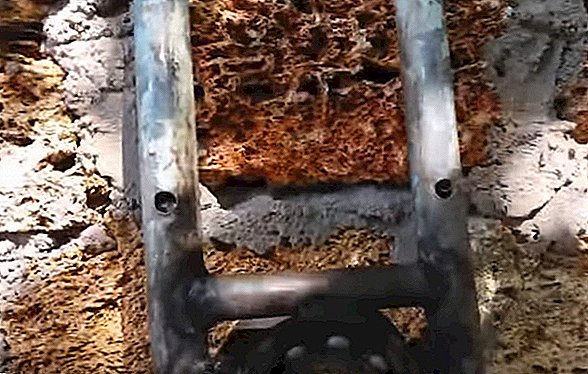
- Mounted rotary part on the basis of the bearing.

- The flange with mounting holes is attached to the bearing.
- The tail is made of metal sheet.

- The design is cleaned and painted.
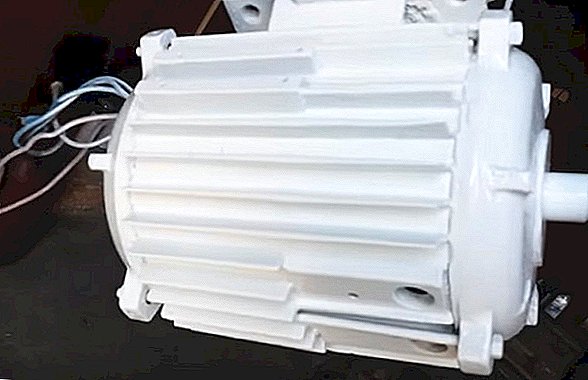
- The tail is colored.
- The protective casing-fairing is made and painted from a thin metal sheet.
- After drying the painted elements, an electric generator is installed on the base, the casing and tail are attached.
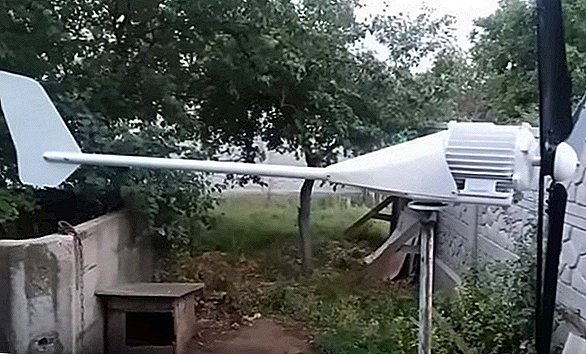
- The blades are mounted on the impeller from the cooling system of the tractor engine.
- Spacers are welded to the blades (in this case, metal blades).
Important! The height of the mast of a wind generator should be at least 6 meters. The foundation is concreted under it.
As you can see, to assemble a wind turbine with your own hands is not so simple. This requires certain skills and knowledge in electrical engineering and electronics. But for people with such knowledge, this task is quite capable. In addition, homemade wind turbine will cost much cheaper than the purchase design.














